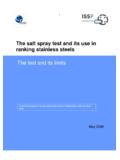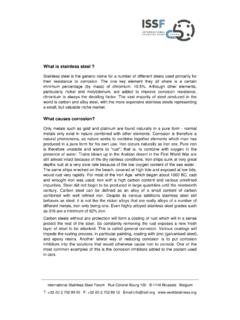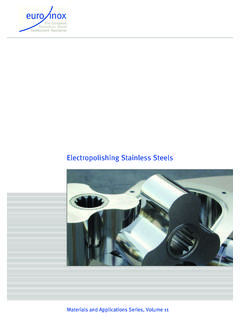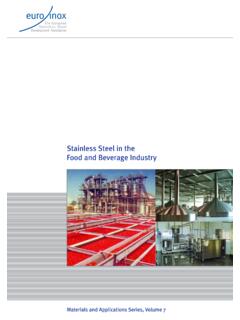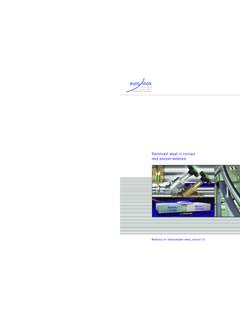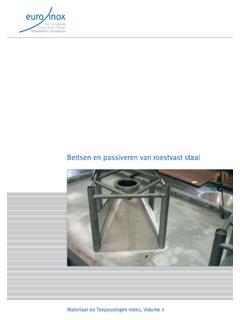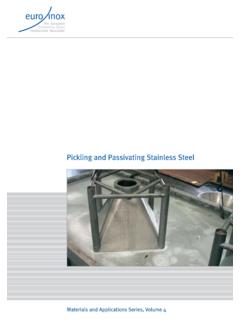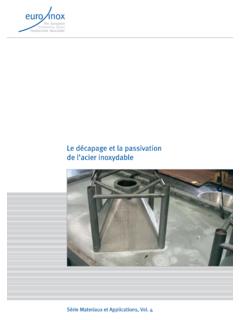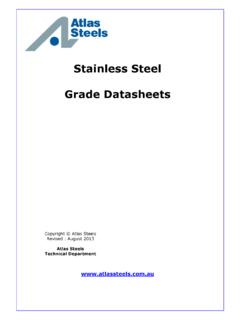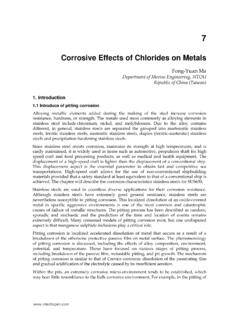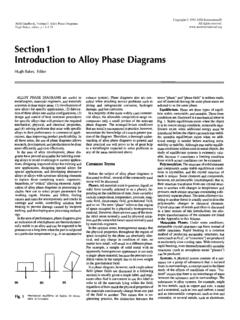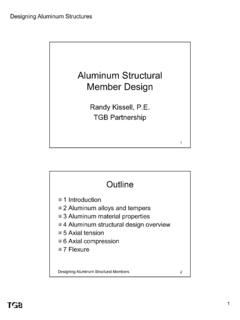Transcription of MANUFACTURE, PROCESSING AND USE OF ... - Stainless …
1 MMAANNUUFFAACCTTUURREE,, PPRROOCCEESSSSIINNGG AANNDD UUSSEE OOFF SSTTAAIINNLLEESSSS SSTTEEEELL:: A REVIEW OF THE HEALTH EFFECTS _____ Prepared by: HJ Cross, J Beach, LS Levy, S Sadhra, T Sorahan, C McRoy Institute of Occupational Health University of Birmingham Edgbaston Birmingham B15 2TT UK Commissioned by: European Confederation of Iron and Steel Industries (EUROFER) Rue du Noyer 211 B-1000 Bruxelles Belgium January 1999 CONTENTS PREAMBLE .. iEXECUTIVE SUMMARY .. iiABBREVIATIONS ..ix 1 METALLIC Stainless STEEL .. METALLIC Stainless STEEL : MASSIVE .. General Information .. Information on Exposure .. Toxicokinetics .. METALLIC Stainless STEEL : POWDER .. HAZARD ASSESSMENT .. RISK ASSESSMENT .. FUTURE RESEARCH NEEDS .. 25 2. Stainless STEEL manufacture .. GENERAL INFORMATION .. TOXICOKINETICS .. TOXICITY.
2 HAZARD ASSESSMENT .. RISK ASSESSMENT .. FUTURE RESEARCH NEEDS .. 41 3 Stainless STEEL PROCESSING .. WELDING OF Stainless STEEL .. General Information .. Information on Exposure .. Toxicokinetics .. Toxicity .. Hazard Assessment .. Risk Assessment .. Future Research needs .. 92 GRINDING OF Stainless STEEL .. General Information .. Information on Exposure .. Toxicokinetics .. Toxicity .. Hazard Assessment .. Risk Assessment .. Future Research needs .. OTHER PROCESSES .. Cutting of Stainless steel .. Polishing of Stainless steel .. Forming of Stainless steel .. 111 APPENDIX 1 .. 112 BIBLIOGRAPHY .. 114 REFERENCE LIST .. 124 i PREAMBLE This review comprises a critical evaluation of available data concerning the health effects associated with Stainless steels, from manufacture through to PROCESSING and end-use.
3 The review has been divided into the following three sections to reflect the qualitative variations in exposure which occur: metallic Stainless steel Stainless steel manufacture Stainless steel PROCESSING The information contained in this review is intended to provide the basis of an assessment of the hazards associated with metallic Stainless steel and those substances which occur during the manufacture and the PROCESSING of Stainless steel. Currently, Stainless steels are classified in the European Union according to the Preparations Directive (88/379/EEC). Consequently, by using the conventional method specified in the Directive, Stainless steels which contain nickel at a concentration of 1% or more are classified as category 3 carcinogens (R40) and skin sensitisers (R43). In this review, identifiable hazards associated with metallic Stainless steel are evaluated against the criteria for classification, as contained in Annex VI of European Council Directive 92/32/EEC, amending Directive 67/548/EEC.
4 The purpose of this evaluation is to establish how, based on currently available data, metallic Stainless steels would be classified if they were substances. Identifiable hazards associated with the materials occurring during the PROCESSING of Stainless steel, for example welding fume or grinding dust, are also evaluated against the same classification criteria. The purpose of this evaluation is to determine how the toxicological properties of the materials concerned correlate with the classification criteria for substances, and thus enable an objective judgement of whether the materials should be considered hazardous. The review is also intended to provide the basis of a risk assessment for those hazards which have been identified. The final part of each section focuses on "future research needs". Gaps in the database, which have been identified during the preparation of this document, are reviewed and suggestions are put forward regarding future research needs where it is thought appropriate.
5 Ii Within the review, each section is divided into the following sub-sections: general information; information on exposure; toxicokinetics; toxicity; hazard assessment; risk assessment; gaps in knowledge. The review was prepared using primary sources of data. In each toxicity sub-section, the review of the epidemiological literature relating to occupational cancers is limited to original publications of cohort studies. Population-based case-control studies were considered to be too problematic to include reliable analyses of detailed occupational exposures and were not evaluated. Literature search strategy Primary sources of published data used in this review were identified using TOXLINE, NIOSHTIC, CISDOC, MEDLINE, HSELINE and the Science Citation Index databases for the period 1970 to 1996 (project start date).
6 Key words used in the searches were Stainless steel , chromium-nickel alloys , and nickel alloys . References were selected from the search results using a two-stage approach. Firstly, reference abstracts were scanned for relevance to the project and selected references were then acquired. Secondly, acquired references were read in full before being selected for inclusion in the review. References included in the review are listed in the "Bibliography"; those not included are given in the "Reference List". References published subsequent to the start of the project, that is for the period 1996 to early 1998, were identified by conducting updated searches using the above databases. Further articles were identified from bibliographies of references used during the course of the project and by scanning scientific journals.
7 Iii EXECUTIVE SUMMARY This document comprises a critical review of the literature relating to health effects associated with Stainless steels, from manufacture through to PROCESSING and end-use. The purpose of the review is to provide an assessment of the hazards associated with metallic Stainless steel, Stainless steel manufacture and Stainless steel PROCESSING , and an evaluation of these hazards against the EU classification criteria1. The review also provides assessments of the associated risks to health and recommendations for further research. Metallic Stainless steel Stainless steels are defined, according to the European Standard EN 10088, as iron-based alloys containing at least chromium and a maximum of carbon. Stainless steels may contain nickel as another major alloying element, with a content of up to 38%, plus other alloying elements and stabilisers.
8 The chromium content renders Stainless steels corrosion resistant. Metallic Stainless steel is produced mainly in the massive form (>99%); the remainder is produced in powdered form. In spite of the absence of data from animal experiments and of human data on acute toxicity, the corrosion resistant properties of Stainless steels, together with evidence of negligible nickel release in leaching studies and lack of activity in human patch-testing studies, suggest that no acute toxicity would be anticipated. This view is supported by the absence of any reports of acute toxicity associated with exposure to metallic Stainless steel despite the extremely large number of individuals who are exposed to Stainless steels on a regular basis. Patch-testing studies, in conjunction with investigations of nickel release, show that prolonged skin contact with most Stainless steel grades is unlikely to elicit a skin response in nickel-sensitised individuals.
9 However, prolonged skin contact with AISI 303, a resulfurised grade of Stainless steel produced specifically for machining purposes, may evoke skin reactions in nickel-sensitised subjects. The small quantity of experimental data for unsensitised subjects provides no evidence that skin contact with Stainless steel induces skin sensitisation. Further, there is an extremely large population exposed to Stainless steels, with either prolonged or intermittent skin contact, or as a result of Stainless steel surgical implants, and there are very few reports of suspected allergic reactions available in the literature. Investigations of prolonged exposure to implanted metallic Stainless steel in animals and case-reports of effects of prolonged exposure to Stainless steel prosthetic implants in humans provide no evidence of specific reactions to Stainless steel over and above non-specific response such as seen with any inert implanted material.
10 1 Annex VI of European Council Directive 67/548/EEC, as amended. iv Results from a single intra-muscular carcinogenicity study provide no evidence for the carcinogenicity in animals of metallic Stainless steel. When data concerning the hazardous properties of metallic Stainless steels are evaluated against the current EU classification criteria, there appears to be no basis for classifying Stainless steels for any of the toxicological end-points. There are gaps in the database for metallic Stainless steels for acute toxicity, carcinogenicity, mutagenicity and reproductive effects. However, based on the physical properties of the material and the negligible bioavailability of Stainless steel constituents, further testing using internationally agreed protocols would not be expected to generate much useful information.
